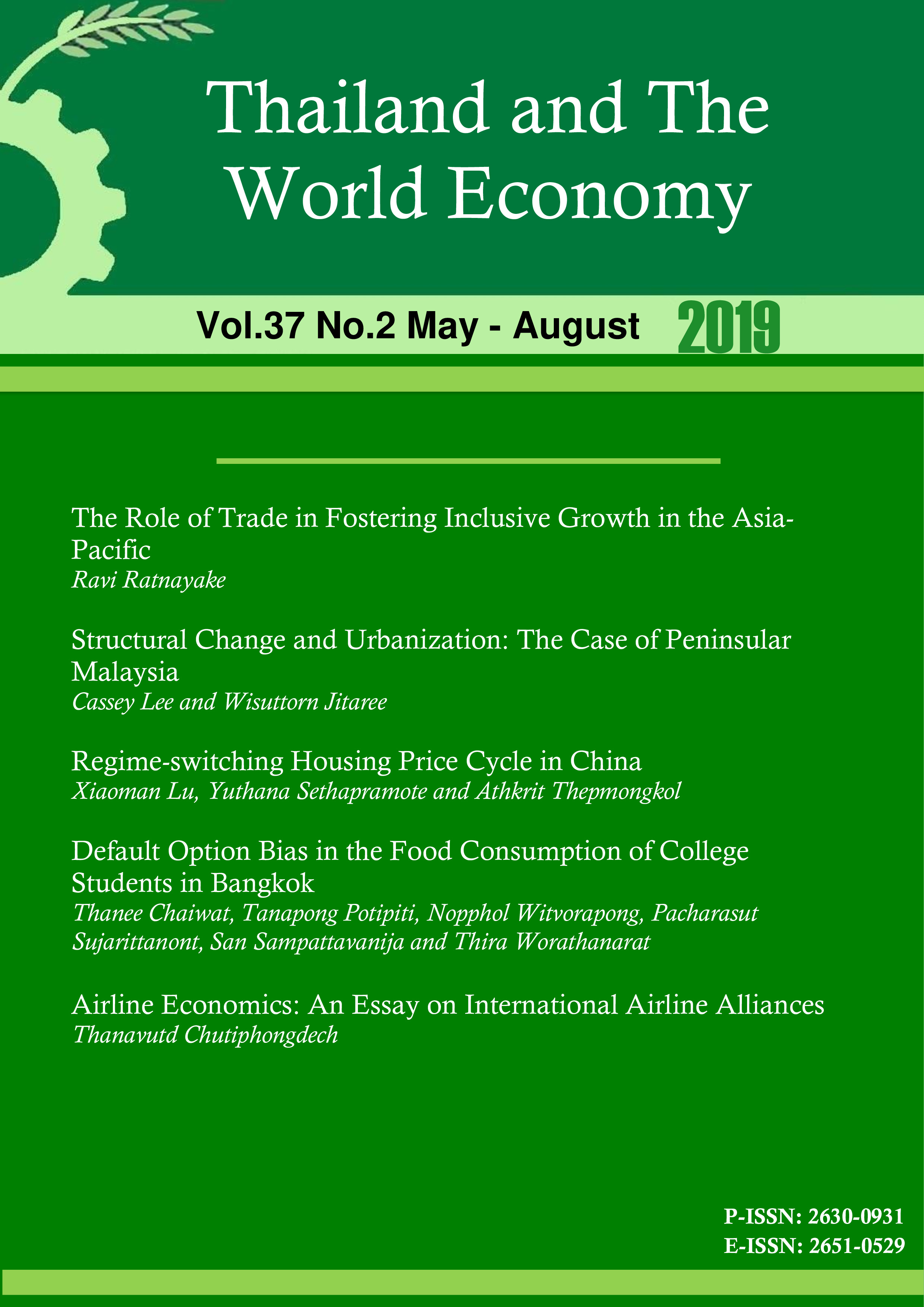The Role of Trade in Fostering Inclusive Growth in the Asia-Pacific
Keywords:
Inclusive growth, Inequality, International opennessAbstract
Rising inequalities in wealth and income, alongside other measures of exclusion, have been observed in both advanced and developing economies in recent decades. These growing disparities are often interpreted as a threat to not only social stability but also future economic prosperity. Changing the dynamics of growth to make it more ‘inclusive’ has therefore become a priority at both the national and international levels. Inclusive growth can be broadly understood as growth that is accessed and shared equitably by all segments of society. In this context, trade and investment are recognised as being intimately linked with issues of employment, income distribution and equality. However, the role that trade and international economic openness plays in generating inclusive growth, and the evidence from the Asia-Pacific region, is not empirically analysed. This paper reviews the trends in growth, and inequality in the Asia-Pacific region before setting out a framework for linking changes in trade with inclusiveness. Next the paper presents cross-country analysis linking inclusivity across four dimensions—aggregate employment, productivity, poverty and income equality, and gender equality—to international openness through trade and investment. The results show that an expansion of trade and investment does not necessarily produce more inclusive development. Rather, a range of complementary policies need to be deployed alongside managed opening of national economies.
References
ADB. (2011). Framework of Inclusive Growth Indicators. Asian Development Bank. https://sustainabledevelopment.un.org/content/documents/739indicators.pdf.
ADB. (2014). Framework of Inclusive Growth Indicators 2014. http://www.adb.org/sites/default/files/publication/42813/ki2014-special-supplement_1.pdf.
Anand, R., Mishra, S., & Peiris, S. J., (2013). Inclusive Growth: Measurement and Determinants. IMF Working Paper, No.13/135, International Monetary Fund.
Barro, R. (2000). Inequality and growth in a panel of countries. Journal of Economic Growth, 5(1), 5-32.
Cingano, F. (2014). Trends in Income Inequality and Its Impact on Economic Growth. OECD Social, Employment and Migration Working Papers. Paris: Organisation for Economic Co-operation and Development. http://www.oecdilibrary.org/content/workingpaper/5jxrjncwxv6j-en.
Dutt, P., Mitra, D., & Ranjan, P. (2009). International trade and unemployment: Theory and cross-national evidence. Journal of International Economics, 78(1), 32-32.
ESCAP. (2013). Asia-Pacific Trade and Investment Report 2013: Turning the Tide: Towards Inclusive Trade and Development. http://www.unescap.org/resources/asia-pacific-trade-and-investment-report-2013-turning-tide-towards-inclusive-trade-and.
ESCAP. (2015). “Economic and Social Survey of Asia and the Pacific 2014: Year-End Update.” http://www.unescap.org/resources/economic-and-social-survey-asia-and-pacific-2014-year-end-update.
Fritz, J. (2013).What complementary policies may contribute to the inclusiveness of international openness?. Background paper prepared for Asia-Pacific Trade and Investment Report 2013, ESCAP Trade and Investment Division, TID Working Paper No. 01, November 2013. Bangkok
Gourdon, J., Maystre, N., & De Melo, J. (2006). Openness, inequality, and poverty : Endowments matter. Policy research working paper, No.3981. Washington, D.C.: World Bank, Development Research Group, Trade Team.
Hasan, R., Mitra, D., Ranjan, P., & Ahsan, R. (2012). Trade liberalization and unemployment: Theory and evidence from india. Journal of Development Economics, 97(2), 269-269.
IMF. (2007). IMF World Economic Outlook (WEO) -- Globalization and Inequality, October 2007. https://www.imf.org/external/pubs/ft/weo/2007/02/.
IPC-IG. (2013). After All, What Is Inclusive Growth?. International Policy Centre for Inclusive Growth.
Juhn, C., Ujhelyi, G., & Villegas-Sanchez, C. (2014). Men, women, and machines: How trade impacts gender inequality. Journal of Development Economics, 106, 179-179.
Lederman, D. (2013). International trade and inclusive growth: A primer. Indian Growth and Development Review, 6(1), 88-112.
Nicita, A. (2009). The price effect of tariff liberalization: Measuring the impact on household welfare. Journal of Development Economics, 89(1), 19-19.
Piketty, T., & Goldhammer, A. (2014). Capital in the twenty-first century (A. Goldhammer, Trans.). Cambridge Massachusetts: Belknap Press of Harvard University Press.
Rodriguez, F., & Rodrik D. (1999). Trade Policy and Economic Growth: A Skeptic’s Guide to Cross-National Evidence. NBER Working Paper, No.7081. National Bureau of Economic Research. http://www.nber.org/papers/w7081.
Ravallion, M. (2006). Looking beyond averages in the trade and poverty debate. World Development, 34(8), 1374-1374.
Rodrik, D.. (2011). The Future of Economic Convergence. National Bureau of Economic Research. http://www.nber.org/papers/w17400.
Sachs, J., Warner, A., Åslund, A., & Fischer, S. (1995). Economic reform and the process of global integration. Brookings Papers on Economic Activity, 1995(1), 1-118.
Spence, Michael. (2012). The Next Convergence: The Future of Economic Growth in a Multispeed World. New York: Picador.
Stieglitz, Joseph E. (2013). The Price of Inequality: How Today’s Divided Society Endangers Our Future. 1 edition. W. W. Norton & Company.
Summers, Lawrence H. (2015). Report of the Commission on Inclusive Prosperity. Name. Accessed January 22. https://www.americanprogress.org /issues/economy/report /2015/01/15/104266/report-of-the-commission-on-inclusive-prosperity/.
The Economist. (2014). The Headwinds Return. September 13. http://www.economist.com /news/briefing/21616891-ten-years-ago-developing-economies-were-catching-up-developed-ones-remarkably-quickly-it.
Topalova, P. (2007). Trade Liberalization, Poverty and Inequality: Evidence from Indian Districts. in Globalization and Poverty, ed. by A. Harrison, pp. 291-335. University of Chicago Press, Chicago.
United Nations. (2012). The Future We Want: Rio+20 Outcome Document. United Nations. http://www.uncsd2012.org/content/documents/727The%20Future%20We%20Want%2019%20June%201230pm.pdf.
United Nations.. (2013). Inequality Matters: Report on the World Social Situation 2013. DESA.
Winters, L. (2000). Trade Liberalisation and Poverty. Poverty Research Unit at Sussex, University of Sussex. http://www.sussex.ac.uk/cpir/documents/wp7.pdf.
United Nations.. (2014). Globalization, Infrastructure, and Inclusive Growth. ADBI Working Paper, No. 464. Asian Development Bank Institute. https://ideas.repec.org/p/ris/adbiwp/0464.html.
World Bank. (2009). What Is Inclusive Growth?. World Bank: Washington, DC. http://siteresources.worldbank.org/INTDEBTDEPT/Resources/468980-1218567884549/WhatIsInclusiveGrowth20081230.pdf.










